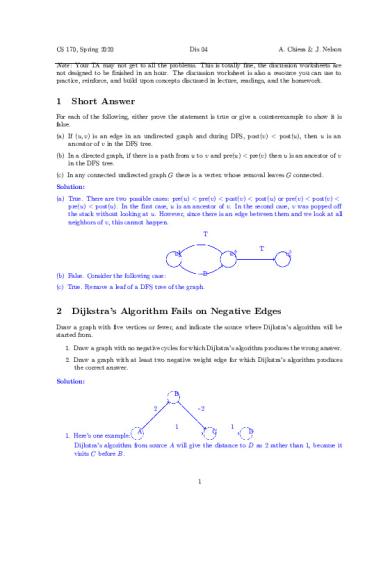Dis04-sol - Discussion section solutions PDF

| Title | Dis04-sol - Discussion section solutions |
|---|---|
| Author | Alan Edmonds |
| Course | Efficient Algorithms And Intractable Problems |
| Institution | University of California, Berkeley |
| Pages | 3 |
| File Size | 104.7 KB |
| File Type | |
| Total Downloads | 78 |
| Total Views | 133 |
Summary
Discussion section solutions...
Description
CS 170, Spring 2020
Dis 04
A. Chiesa & J. Nelson
Note: Your TA may not get to all the problems. This is totally fine, the discussion worksheets are not designed to be finished in an hour. The discussion worksheet is also a resource you can use to practice, reinforce, and build upon concepts discussed in lecture, readings, and the homework.
1
Short Answer
For each of the following, either prove the statement is true or give a counterexample to show it is false. (a) If (u, v) is an edge in an undirected graph and during DFS, post(v) < post(u), then u is an ancestor of v in the DFS tree. (b) In a directed graph, if there is a path from u to v and pre(u) < pre(v) then u is an ancestor of v in the DFS tree. (c) In any connected undirected graph G there is a vertex whose removal leaves G connected. Solution: (a) True. There are two possible cases: pre(u) < pre(v) < post(v) < post(u) or pre(v) < post(v) < pre(u) < post(u). In the first case, u is an ancestor of v. In the second case, v was popped off the stack without looking at u. However, since there is an edge between them and we look at all neighbors of v, this cannot happen. T T
w61
u32
v45
B
(b) False. Consider the following case:
(c) True. Remove a leaf of a DFS tree of the graph.
2
Dijkstra’s Algorithm Fails on Negative Edges
Draw a graph with five vertices or fewer, and indicate the source where Dijkstra’s algorithm will be started from. 1. Draw a graph with no negative cycles for which Dijkstra’s algorithm produces the wrong answer. 2. Draw a graph with at least two negative weight edge for which Dijkstra’s algorithm produces the correct answer. Solution: B 2
1. Here’s one example:
A
-2 1
C
1
D
Dijkstra’s algorithm from source A will give the distance to D as 2 rather than 1, because it visits C before B .
1
CS 170, Spring 2020
Dis 04
A. Chiesa & J. Nelson
2. Dijkstra’s algorithm always works on directed paths. For example: A
3
-1
B
-2
C
More Short Answer Questions
(a) Let G be a dag and suppose the vertices v1 , . . . , vn are in topologically sorted order. If there is a path from vi to vj in G, are we guaranteed that i < j ? (b) Let G = (V, E) be any strongly connected directed graph. Is it always possible to remove one vertex (as well as edges to and from it) from the graph so that the remaining directed graph is strongly connected? (c) Give an example where the greedy set cover algorithm does not produce an optimal solution. (d) Let G be a connected undirected graph with positive lengths on all the edges. Let s be a fixed vertex. Let d(s, v) denote the distance from vertex s to vertex v, i.e., the length of the shortest path from s to v. If we choose the vertex v that makes d(s, v) as small as possible, subject to the requirement that v 6= s, then does every edge on the path from s to v have to be part of every minimum spanning tree of G? (e) The same question as above, except now no two edges can have the same length. Solution: (a) Y es Consider a path vi1 → · · · → vik . Since the graph is in topological order, we can conclude that ij < ij+1 for j = 1, . . . , k − 1, so by transitivity, i1 < ik . (b) N o Consider the graph with 3 nodes a, b and c and edges a → b, b → c and c → a. (c) With items B = {a, b, c, d, e, f } and sets {a, b, c }, {d, e, f }, {a, b, d, e} we would first choose {a,b,d,e} which would then require all three sets, while choosing the first two sets is sufficient. a 1
1
c b 1 (d) False. Consider the following counterexample: Take s = a. Both v = b and v = c minimize d(a, v), but neither edge is part of every MST: for instance, (a, b) and (b, c) form a minimum spanning tree that does not contain (a, c). (e) True. First let’s analyze the the definition. We need to find a vertex v that minimizes d(s, v). Because the edge weights are positive, v has to be a neighbor a s. Or in other words, part (h) claims the lightest edge that is incident on s has to part of every minimum MST. Let us call this edge e. Assume, for contradiction, that e is not part of some MST T . Let us add e to T . This creates a cycle, which goes through e to s and exit s through another edge e′ . We now remove e′ . Removing an edge from a cycle keeps the graph connected and a tree. This creates a tree which is lighter than T which contradicts our assumptions that T is a MST.
2
CS 170, Spring 2020
4
Dis 04
A. Chiesa & J. Nelson
Unique Shortest Path
Shortest paths are not always unique: sometimes there are two or more different paths with the minimum possible length. Show how to solve the following problem in O((|V | + |E|) log |V |) time. Input: An undirected graph G = (V, E); edge lengths le > 0; starting vertex s ∈ V . Output: A Boolean array usp[·]: for each node u, the entry usp[u] should be true if and only if there is a unique shortest path from s to u. (Note: usp[s] = true.) [Provide 3 part solution.] Solution: Main Idea: Suppose there are two different shortest paths from s to u. These two paths can either share the same last edge (the edge ending at u), or not. If they do, this can be detected by modifying Dijkstra’s to detect if a node has been added to the known region previously with the same distance. If not there must be two different shortest paths to u’s parent, which can be detected by propagating (for every edge (a, b)) usp(a) to usp(b) if decreasekey(H, v) is called. Pseudocode: This can be done by slightly modifying Dijkstra’s algorithm. The array usp[·] is initialized to true in the initialization loop. The main loop is modified as follows (lines 7-9 are added): 1: while H is not empty do 2: u = deletemin(H ) 3: for all (u, v) ∈ E do 4: if dist(v) > dist(u) + l(u, v) then 5: dist(v) = dist(u) + l(u, v) 6: decreasekey(H, v) 7: usp[v] = usp[u] 8: else if dist(v) = dist(u) + l(u, v) then 9: usp[v] = false Proof of Correctness: By Dijkstra’s proof of correctness, this algorithm will identify the shortest paths from the source u to the other vertices. For uniqueness, we consider some vertex v. Let p denote the shortest path determined by Dijkstra’s algorithm. If there are multiple shortest paths, then take another path p′ 6= p and it will either share the same final edge (w, v) (for some vertex w) as p, or they have different final edges from p. In the former case, there must be multiple shortest paths from u to w. Using an inductive argument, which supposes that usp is already set correctly for all vertices that are closer than v, this will be detected in the first conditional statement when the algorithm explores from w and updates the distance to v by taking edge (w, v), as it will detect that there are multiple shortest paths to w. In the latter case, if the last edges of the two shortest paths are (w1 , v) and (w2 , v), then since edge lengths le > 0, both w1 and w2 must be visited before v, thus the algorithm will detect the existence of multiple shortest paths with the second conditional statement. The base case is true because there is a unique shortest path from the source s to itself. Runtime: The runtime analysis follows that of Dijkstra’s, and will run in the required time when a binary heap is used for the priority queue.
3...
Similar Free PDFs

Lab 1- Discussion Section
- 1 Pages

Section 1
- 8 Pages

Section 5LPGeometry
- 17 Pages

Results section
- 3 Pages

Section 1317E
- 6 Pages

Section 51A vs Section 51 CPC
- 6 Pages

Topic 8-Section 92 and section 90
- 19 Pages
Popular Institutions
- Tinajero National High School - Annex
- Politeknik Caltex Riau
- Yokohama City University
- SGT University
- University of Al-Qadisiyah
- Divine Word College of Vigan
- Techniek College Rotterdam
- Universidade de Santiago
- Universiti Teknologi MARA Cawangan Johor Kampus Pasir Gudang
- Poltekkes Kemenkes Yogyakarta
- Baguio City National High School
- Colegio san marcos
- preparatoria uno
- Centro de Bachillerato Tecnológico Industrial y de Servicios No. 107
- Dalian Maritime University
- Quang Trung Secondary School
- Colegio Tecnológico en Informática
- Corporación Regional de Educación Superior
- Grupo CEDVA
- Dar Al Uloom University
- Centro de Estudios Preuniversitarios de la Universidad Nacional de Ingeniería
- 上智大学
- Aakash International School, Nuna Majara
- San Felipe Neri Catholic School
- Kang Chiao International School - New Taipei City
- Misamis Occidental National High School
- Institución Educativa Escuela Normal Juan Ladrilleros
- Kolehiyo ng Pantukan
- Batanes State College
- Instituto Continental
- Sekolah Menengah Kejuruan Kesehatan Kaltara (Tarakan)
- Colegio de La Inmaculada Concepcion - Cebu








